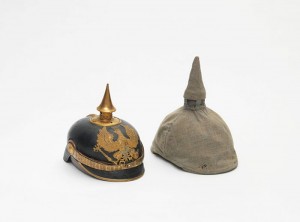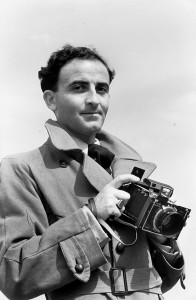“Our inclination to hopefulness and expectations of a final victory are unabated and yet the long wait does at times begin to worry us.”
The cultural and literary historian Ludwig Geiger, son of the famous reformist rabbi Abraham Geiger, penned these lines to a friend on 5 December 1914. The “long wait” which had started to trouble him four months after the Great War broke out, ultimately dragged on for almost four more years and yet failed to bring the victory so yearned for. Soldiers at the time could barely imagine what massive destruction this first modern war would wreak. The paltry equipment with which they set off for the front is proof enough of that.

Dr Max Litthauer’s Pickelhaube (spiked helmet) with camouflage covering, 1914–1918. Donated by Bart Ullstein © Jewish Museum Berlin, photo: Jens Ziehe.
On display both in the exhibition “The First World War in Jewish Memory” at the Jewish Museum Berlin and in the special exhibition “1914–1918. The First World War” at the German Historical Museum (DHM) are Pickelhauben, spiked helmets made of hardened (boiled) leather and with a cloth covering for camouflage—for a metal spike protruding above a trench and catching the sunlight made its wearer a sitting target. On my guided tours of the two exhibitions, I take the Pickelhaube as an opportunity to talk about how much this war differed from previous ones as well as how ill-prepared the military was, initially, for the new weaponry deployed.
→ continue reading
108 years ago, on 29 September 1906, in the Neukölln neighborhood of Berlin, the photographer Herbert Sonnenfeld caught his first glimpse of the light of the world.
His photographs constitute one of the largest and most important portfolios in the Jewish Museum Berlin’s photographic archive. The Sonnenfeld collection consists of some 3000 negatives taken between 1933 and 1938. Along with Abraham Pisarek and Arno Kikoler, Sonnenfeld is one of the few Jewish photographers to document Jewish life in and around Berlin in the 1930s, passing down to us today an unparalleled photographic witness to that period.

Herbert Sonnenfeld, photograph by Leni Sonnenfeld, Berlin ca. 1935
© Jewish Museum Berlin, purchased with funds provided by Stiftung DKLB
Herbert Sonnenfeld first worked as an insurance employee before being laid off as a result of the Nazi regime’s anti-Semitic measures. He came to photography circuitously and was an autodidact. Following a trip to Palestine in 1933, his wife Leni approached various Jewish newspapers and offered them her husband’s pictures. They were enthusiastic, promptly bought up the prints, and asked for more. Thus began Sonnenfeld’s career as a press photographer.
→ continue reading

“Enthüllungen über das tragische Lebensende Lassalles” (An Exposé of the Tragic Death of Lassalle) by Bernhard Becker © Jewish Museum Berlin, photo: Leonore Maier
150 years ago today – on the last day of August, 1864 – Ferdinand Lassalle died as a result of injuries sustained in a duel. The German politician and journalist was a founder of the first workers’ organization in the country, the General German Workers’ Association, which had come into being the year before his death and is today still considered “the birthplace of social democracy”. Ferdinand Lassalle’s duel pistols were on display at the exhibition “150 Years of Social Democracy”, presented a year ago by the Moscow State Archive.
Both a politician and a charismatic agitator for the organization of workers, Lassalle was only 39 years old when he challenged Wilhelm von Dönniges to a duel because the latter had refused to grant Lassalle his daughter’s hand in marriage.
After his abrupt demise, a veritable cult of personality developed around his memory: there were poems, songs, even rituals carried out during the widespread commemoration ceremonies, as well as various pieces of memorabilia that circulated among his followers. The first book with “An Exposé of the Tragic Death of Lassalle” appeared in 1868, by one of his close political comrades.
→ continue reading


